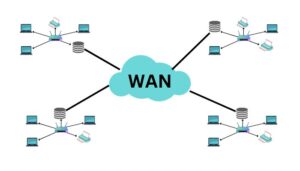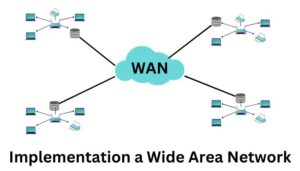The Benefits and Challenges of Implementing a Wide Area Network for Your Business
Welcome to the world of Wide Area Networks, where technology meets adventure! If you’re considering implementing a wide area network (WAN) for your business, get ready for an exciting and challenging journey. WAN is a network that connects multiple locations and allows for efficient communication and collaboration between geographically dispersed teams.
While this offers many benefits, such as increased productivity and better team collaboration, it also comes with its own set of challenges.

Now, don’t get me wrong, a WAN can be an exciting and valuable asset to your business. It can bring you closer to your remote teams, help you save on travel costs, and allow for greater flexibility in your work. But like any adventure, it’s important to be prepared for what happens next.
Choosing the right WAN provider can be daunting with so many options available. The key is knowing what to look for, asking the right questions, and learning from the experiences of those who have gone before you.
This blog will look closely at the benefits and challenges of implementing a WAN for your business. We’ll explore the different WAN technologies available and give tips on how to choose the right provider.
We’ll also learn about WAN security’s best practices and techniques for optimizing WAN performance. To top it off, we’ll share real-world examples of companies that have successfully implemented WANs and the lessons they learned. So gear up and prepare for an adventure in the world of WAN!
Benefits of Implementing a WAN
Are you tired of slow application performance and unreliable network connections? Do you have multiple locations that need to be connected for efficient data sharing and collaboration?
If so, it may be time to consider implementing a wide area network for your business.WANs provide a secure and efficient way to transmit data and connect multiple locations while also providing centralized management and control of network infrastructure.
With enhanced data security and backup capabilities, improved application performance and user experience, and enhanced disaster recovery and business continuity, the WAN has become an increasingly popular solution for businesses of all sizes.
In this section, we’ll explore the benefits of implementing a WAN for your business and discuss how it can help you achieve your goals of improved efficiency and collaboration.
Whether you’re a small business with just a few locations or a large enterprise with a global presence, a WAN can be the key to unlocking the full potential of your network. Here are some key points
- Centralized Management and Control of Network Infrastructure: WAN enables centralized management and control of your entire network infrastructure from a single location. This makes it easier for network administrators to monitor and troubleshoot issues, allocate bandwidth and resources, and enforce security policies across locations. With a WAN, businesses can ensure consistency and standardization across their network infrastructure, simplifying network management and lowering costs.
- Enhanced data security and backup capabilities: WANs provide businesses with a more secure way to transmit and store data. It encrypts sensitive information and provides a centralized data backup and recovery location. In a disaster, data can be quickly restored from a remote location, ensuring business continuity and minimising downtime.
- Improved application performance and user experience: WANs can enhance application performance and user experience by optimizing network traffic, reducing latency, and providing faster access to centralized resources such as applications and databases. This results in a more efficient and productive work environment for the employees. With a WAN, businesses can ensure that all users have the same level of access to network resources, regardless of where they are located.
- Advanced Disaster Recovery and Business Continuity: WAN enables businesses to implement disaster recovery and business continuity plans that include data replication and backup. In the event of an outage at one location, employees can continue to work from other locations, ensuring business continuity. WANs also allow businesses to quickly and easily add or remove network resources as needed, which is critical for scaling and growth.
- Improved communication and collaboration among geographically dispersed teams: A WAN enables employees across multiple locations to collaborate and communicate seamlessly, which increases productivity and efficiency. With a WAN, businesses can ensure that all employees have access to the same data and resources, regardless of their location. This makes it easy for teams to work together on projects and ensure everyone is on the same page.
In short, implementing a WAN can provide businesses with a more efficient, secure, and scalable way to transmit data and collaborate across multiple locations. It can also provide the tools needed for disaster recovery and business continuity planning, which is essential for maintaining uptime and minimizing downtime.
Challenges of Implementing a WAN
Ah, WAN implementation – the Wild West of IT infrastructure. It’s like the ultimate showdown between the good intentions of your network and the relentless challenges that come with it. Think of it as a western movie, but instead of gunslingers, you have compatibility issues and security risks. And like a cowboy, you’ve got to be quick on the draw if you want to overcome the challenges of implementing a wide area network.
But let’s be honest; implementing a WAN can be daunting, especially for new businesses. With the increased complexity and cost, the reliance on reliable Internet connectivity, and the need for specialized IT expertise and resources, it’s no wonder that businesses can feel a little overwhelmed. And don’t even get me started on compatibility issues with legacy systems and applications – it’s like trying to teach a horse to drive a car.
However, fear not, dear reader! With the right approach and a little know-how, you can overcome the challenges of implementing a WAN and take your business to the next level. So get ready, get involved, and let’s take a closer look at the challenges you’ll face when implementing a wide area network. Here are some challenges that you might face during WAN implementation
- Increased complexity and cost compared to local area networks: WANs can be more complex and expensive to implement and maintain than LANs, especially for large and geographically dispersed organizations. This is due to the need for additional hardware and software, specialized IT expertise, and ongoing maintenance and support.
- Dependence on reliable and high-speed Internet connectivity: WANs require reliable and high-speed Internet connectivity to ensure that data is transmitted quickly and efficiently between different locations. If the Internet connection is slow or unstable, it may negatively affect the performance and user experience of the application.
- Security risks from exposure to external networks and devices: WANs are exposed to external networks and devices, which can pose security risks to businesses. They must ensure that their network infrastructure and security protocols are robust and up-to-date to prevent unauthorized access, data breaches, and other cyber threats.
- Requires specialized IT expertise and resources: Implementing and maintaining a WAN requires specialized IT expertise and resources, which can be challenging for small and medium-sized businesses. They may need to hire additional IT staff or outsource network management to a third-party provider.
- Compatibility issues with legacy systems and applications: WANs can have compatibility issues with legacy systems and applications that may not be designed to work with modern network infrastructure. Businesses must ensure that their legacy systems and applications can be integrated with the WAN or consider upgrading to newer technologies.
In short, while WANs offer many benefits to businesses, implementing one can also come with its own set of challenges. These include increased complexity and cost compared to LANs, reliance on reliable and high-speed Internet connectivity, security risks from exposure to external networks and devices, the need for specialized IT expertise and resources, and compatibility issues with legacy systems and applications.
Businesses should consider these challenges carefully when deciding whether or not to implement a WAN and work with experienced network professionals to ensure a successful implementation.
Best Practices for Implementing a WAN
Implementing a wide area network is like trying to fold a fitted sheet – no matter how hard you try, it always turns out to be a mess. But fear not, my fellow IT comrades! With the right tools and strategies, you can fold that WAN into one neat and tidy package.
While implementing a WAN can be a complex task, it doesn’t have to be a nightmare. Think of it like baking a cake – you need the right ingredients and a solid recipe to ensure a successful result. And like baking, WAN implementation can involve trial and error, but with the right best practices, you can mitigate potential disasters.
So, let’s whip up a WAN that’s both functional and tasteful — I mean, reliable. From setting clear goals and selecting the proper hardware and software to test and troubleshoot, we’ll cover all the key best practices for implementing a WAN. By the end of this article, you’ll have a recipe for Van’s success—or at least a killer cake recipe to impress your coworkers.
Key points to remember during WAN implementation.
- Define your business needs: Before implementing a WAN, it is important to define your business needs, such as the amount of data to be transmitted, the number of remote locations and expected network performance. This will help you choose the right WAN solution that meets your business needs.
- Choose the right WAN technology: There are many WAN technologies available, such as MPLS, VPN, and SD-WAN. Each has its own benefits and drawbacks, so it’s important to choose the right one based on your business needs and budget.
- Select a reliable service provider: When selecting a WAN service provider, look for one with a proven track record of providing reliable and high-performance WAN solutions. You should also consider factors such as service level agreements, customer support, and scalability.
- Optimize network performance: To ensure optimal network performance, you should consider using Quality of Service (QoS) to prioritize important traffic, such as voice and video, over less important traffic. You should also monitor network performance and make adjustments as necessary.
- Implement strong security measures: WANs are exposed to external networks and devices, so it is important to implement them to prevent unauthorized access and data breaches. This includes using firewalls, intrusion detection and prevention systems, and encryption.
- Train your staff: Implementing a WAN requires specialized IT expertise, so it’s important to train your IT staff to manage and maintain the network infrastructure. This will help ensure smooth implementation and continued support for your WAN.
- Have a Disaster Recovery Plan: Since WANs are critical to business operations, it is important to have a disaster recovery plan in place to ensure business continuity in the event of a network outage or other disaster.
In short, implementing a WAN can be a complex and challenging process, but following these best practices can help ensure your WAN’s successful implementation and ongoing management.
Types of WAN Technologies
In today’s hyper-connected world, businesses need reliable and efficient ways to connect and communicate with their geographically dispersed teams, partners and customers. That’s where wide area networks come in, providing the basis for seamless connectivity and data transfer over large distances.
But with the wide variety of WAN technologies available, it can be challenging to know which is right for your business. From circuit-switched and packet-switched to frame relay, ATM, MPLS, and VPNs, each technology offers its own unique features and benefits, making the decision process even more complex.
So, how do you determine which WAN technology is best for your business needs?
This article will briefly overview the most common types of WAN technologies, their benefits, and their limitations. By the end of this article, you will better understand the different WAN technologies available and can make an informed decision about which one to choose.
Several types of WAN technologies are available, each with unique features and benefits. Here are some of the most common types of WANs:
- Packet-Switched WAN: This technology breaks data into packets and sends them over a shared network link. This allows for more efficient use of network resources and greater scalability.
- Circuit-Switched WAN: This technology establishes a dedicated physical circuit between two endpoints and maintains it for the duration of the communication. It is commonly used for voice communication and is not as common for data communication.
- Virtual Private Network (VPN): This technology uses encryption and tunnelling protocols to create a secure, private network over a public network such as the Internet. This is a cost-effective option for remote employees or businesses with multiple locations.
- Asynchronous Transfer Mode (ATM): This technology uses cell-based transmission to transport data over the network. It provides high-speed connectivity and is often used for video and voice applications.
- Frame Relay: This technology uses virtual circuits to send data across a wide area network. It is a cost-effective option for businesses that require reliable, high-speed connectivity between multiple locations.
- Multiprotocol Label Switching (MPLS): This technology uses labels to direct data over the network, providing efficient routing and faster network speeds.
Each of these technologies has its own advantages and disadvantages, and the choice of technology will depend on your business’s specific needs and requirements.
Choosing the Right WAN Provider
Choosing the right WAN provider is important for any business looking to build or improve its network infrastructure. With so many providers on the market, it can be challenging to determine which one is right for your business. Here are some important factors to consider when choosing a WAN provider.
- Pricing: The cost of WAN services can vary widely between providers, so it’s important to consider your budget and the features you need.
- Performance: WAN performance is an important factor for any business, as it can affect the efficiency and reliability of your network. Look for a provider that offers high-speed connectivity and low latency to ensure fast data transmission and application performance.
- Support: A WAN provider with excellent support can help you quickly resolve any issues that may arise and minimize downtime. Ensure the provider offers 24/7 support and has a reliable and responsive customer service team.
- Network coverage: The WAN provider you choose must have network coverage in your business areas. Check the provider’s coverage map and ensure they have a strong presence in your target areas.
- Security features: WAN networks are often exposed to external threats, so it’s essential to choose a provider that offers strong security features, including encryption, firewalls, and intrusion detection and prevention.
In addition to considering these factors, you should also ask potential providers important questions to help you make an informed decision. Some questions you may want to ask :
- What are your network availability and uptime guarantee?
- What are your service level agreements (SLAs) for response times and problem resolution?
- Do you offer any additional security features or services?
- What types of WAN technologies do you support?
- Can you provide references from other clients in my industry?
Finally, reading case studies and reviews of leading WAN providers can provide valuable information about their performance, capabilities, and customer satisfaction. This information can help you make an informed decision and choose a provider that aligns with your business objectives and provides the best value for your investment.
WAN Security Best Practices
Security should be at the top of your priority list regarding your business’s Wide Area Network. With the increasing reliance on technology and the Internet, the risks of cyber threats and attacks are greater than ever. Therefore, taking appropriate measures to secure your WAN and protect your business from potential breaches and data theft is important.
Here are the key factors to consider for WAN security:
- Common security threats and vulnerabilities in the WAN, such as unauthorized access, data breaches, malware, and phishing attacks
- Strategies for securing your WAN, including encryption, firewalls, access controls, and regular security audits
- Compliance considerations for industries with regulatory requirements, such as the healthcare, finance and government sectors
- Cost and budget for implementing and maintaining security measures, including hardware, software, and personnel expenses
- Scalability and flexibility of security solutions to accommodate changing business needs and growth
- The quality and reliability of WAN service providers, including their track record in security and compliance
- Availability of technical support and resources from the WAN provider or third-party security vendors
- User education and training on best security practices, such as password management, device hygiene, and incident reporting.
WAN Optimization Techniques
Slow Internet speeds and network performance can be significant issues for businesses dependent on Wide area networks to connect their geographically dispersed offices. Fortunately, various technologies and tools are available to optimize WAN performance and ensure a seamless user experience.
From compression and deduplication to traffic shaping and protocol optimization, WAN optimization can help businesses improve application performance, reduce network congestion, and ultimately save time and money. This topic will explore some of the most effective WAN optimization techniques and how they can benefit your business.
Techniques for maximizing WAN performance and minimizing latency
Here are some key points for maximizing WAN performance and minimizing latency through techniques such as traffic shaping and compression:
- WAN optimization techniques are critical to maintaining high network performance and reducing latency, which can significantly impact user experience and productivity.
- An important technique for optimizing WAN performance is traffic shaping. It involves prioritizing traffic according to its importance and using QoS (quality of service) mechanisms to ensure that mission-critical traffic takes up enough bandwidth.
- Another technique for WAN optimization is data compression, which reduces the size of data packets transmitted across a network, thereby reducing bandwidth usage and speeding up data transfer times.
- Data deduplication is another important technique for WAN optimization, which involves identifying and removing redundant data from network traffic, reducing bandwidth usage, and optimizing performance.
- WAN optimization may also include the use of caching, in which frequently accessed data is stored on local devices or in remote locations to reduce the need for repeated data transfers over the network.
- Other techniques for WAN optimization may include protocol optimization, packet coalescing, and TCP/IP acceleration, all designed to reduce latency and improve network performance.
Overall, WAN optimization technology ensures that your network operates at peak efficiency with minimum latency and maximum bandwidth utilization. By taking advantage of these technologies, you can minimize the impact of network performance issues and ensure that your users can access the applications and data they need to be productive.
Advantages and disadvantages of WAN optimization technologies
Advantages:
- Faster data transfer: WAN optimization technologies can reduce latency and network congestion, resulting in faster data transfer and better application performance.
- Cost savings: WAN optimization technologies can reduce bandwidth usage and improve network efficiency, resulting in cost savings.
- Better user experience: Better network performance can lead to a better user experience and increased productivity.
- Improved data security: Some WAN optimization technologies provide data compression and encryption, improving data security and reducing the risk of data breaches.
Disadvantages:
- Implementation complexity: WAN optimization technologies can be complex to implement and require specialized expertise, which can increase implementation time and cost.
- Cost: WAN optimization techniques can be high, especially for large organizations or those with many branch offices.
- Limited Compatibility: Some WAN optimization technologies may not be compatible with specific applications or systems, limiting their effectiveness.
- Vendor dependency: Organizations may become dependent on a single vendor for their WAN optimization technology, limiting flexibility and increasing the risk of vendor lock-in.
Real-World Examples of WAN Implementation
In today’s interconnected world, a wide area network has become an essential component of business infrastructure. A WAN can increase productivity and collaboration by connecting geographically dispersed offices and allowing remote access to corporate resources.
But what exactly does a successful WAN implementation look like? In this article, we’ll explore real-world examples of companies successfully implementing WANs and the lessons they learned.
Companies of all sizes, from small startups to large enterprises, have recognized the benefits of WANs. But the road to implementation may be fraught with challenges. By examining case studies of successful implementations, businesses can gain valuable insight into best practices for planning, designing, and managing a WAN.
Furthermore, these examples can help identify potential pitfalls and offer solutions to overcome them. Whether you’re considering implementing a WAN or optimizing an existing WAN, real-world examples provide a roadmap to success.
Companies that have successfully implemented WANs
- Starbucks: The popular coffee chain implemented a WAN to connect all of its stores and streamline its operations. This allowed them to manage inventory, sales and customer data more efficiently.
- Coca-Cola: The beverage giant implemented a global WAN to connect its offices and facilities worldwide. This allowed for a faster communication, better collaboration, and increased productivity.
- Volvo: The automotive company implemented a WAN to connect its global offices and manufacturing plants. This improved production, supply chain management, and quality control coordination.
- Marriott: The hospitality company implemented a WAN to connect its hotels and streamline its booking and reservation systems. This allowed for better customer service and improved efficiency.
- Dell: The computer maker implemented a WAN to connect its global offices and data centres. This allowed for faster data transfer, better collaboration, and improved disaster recovery capabilities.
Finally, implementing a WAN can provide several benefits to a business, including centralized management, enhanced data security and backup capabilities, improved application performance and user experience, improved disaster recovery and business continuity, and greater flexibility for geographically dispersed teams.
Better communication and collaboration between However, WAN implementation also presents its own set of challenges, such as increased complexity and cost compared to local area networks, reliance on reliable and high-speed Internet connectivity, security risks, and compatibility issues with legacy systems and applications.
To ensure a successful implementation, it is important to follow best practices for WAN implementation, choose the right WAN provider, secure your WAN with best practices, and apply techniques to maximize WAN performance and minimize latency.


